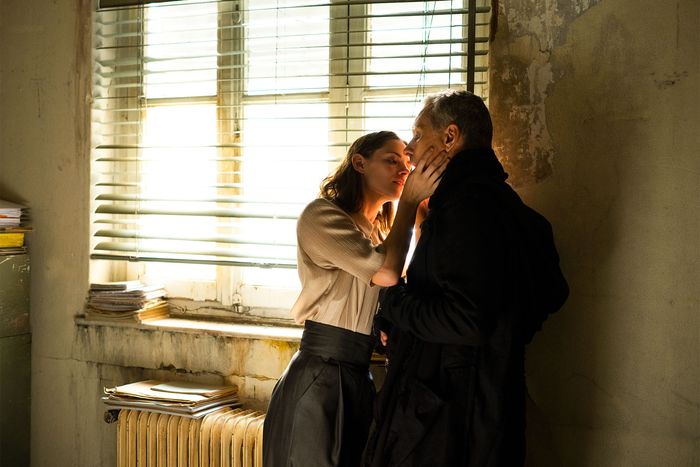
Viggo Mortensen plays an artist with the magnificent name of Saul Tenser in Crimes of the Future, though whether he’s truly a creative force or just a source of material is a point of onscreen debate. Does the tendency to sprout new internal organs that are then removed in front of a live audience count as an art of will or a symptom of a rebelling body? Either way, Saul’s not alone in finding his form changing in ways he can’t predict. He and Caprice (Léa Seydoux), his partner professionally and in life, inhabit an emptied-out industrial future in which humanity has begun mutating and losing its ability to feel pain. Outré and amateur surgery has become the norm, practiced in bloody, blissed-out huddles on the street, and performance art has become the most vaunted and idolized of occupations. Caprice and Saul have become celebrities in their pared-down world for an act that involves Saul lying inside a modified sarcophagus originally intended for autopsies, and Caprice using its tools to remove the latest growth he’s sprouted as a symptom of the “Accelerated Evolution Syndrome” he suffers from.
Their burning eyes and ecstatic gasps broadcast what an admirer named Timlin (Kristen Stewart) will soon breathlessly insist: “Surgery is sex, isn’t it? Surgery is the new sex.” It’s an irresistible claim, one that could double as a tagline, but the truth is that it’s death, not sex, that looms over Crimes of the Future. The film marks David Cronenberg’s long-awaited return to the body-horror genre in which he’s been such a defining force, and from which he’s wandered over the last decade or so. But while Crimes of the Future, which shares a title and little else with an early entry in the filmmaker’s career, is filled with imagery that’s downright, well, Cronenbergian, from surreal medical equipment to devices that look organic in nature and extremely Freudian in their design, the filmmaker’s heart (and gonads) just isn’t into it. Seydoux may exude voluptuous sensuality, and Stewart may be performing a whispery, dystopian take on a sultry librarian, but the film itself has an aloof, clinical quality. What interests it is not the potential of our physical forms for pleasure and revulsion, but their inevitable failure.
When Caprice peers into Saul’s abdomen with what looks like a variation on a jeweler’s loupe and tells him about his latest organ, he murmurs, “I thought I was all tapped out, dried up.” It’s hard not to read the line as coming from Cronenberg directly. Crimes of the Future is the director’s first feature in eight years, since Maps to the Stars, and while he’s hardly been inactive since then, the film has an unmistakably late-career air. It feels exhausted, a sense mirrored in Mortensen’s performance of Saul as a man who seems to be dying in slow motion, constantly being cradled and jostled by H.R. Giger–esque devices that help him sleep and eat. Mortensen rasps his every line between dry-mouthed smacks and gurgles, a misophonic’s nightmare, and regards the world with the wry resignation of someone no longer able to move through it easily. Mortensen, burnished and silvery at 63, is better preserved than most of us mortals will be at any age, but he’s nevertheless an avatar of aging, someone whose body has been betraying him for long enough that he regards its changes with a removed curiosity more than anything else.
Crimes of the Future isn’t a terrible movie, but it’s so relentlessly moribund, barely staggering through the half-formed narrative giving it structure. There’s a dead child whose father, Lang Dotrice (Scott Speedman), lingers in Caprice and Saul’s orbit for reasons that are gradually revealed. There’s a National Organ Registry, overseen by Wippet (Don McKellar) and Timlin, which doesn’t officially exist yet but which nevertheless keeps track of changes in people like Saul. And there’s Berst (Tanaya Beatty) and Router (Nadia Litz), technicians working for the company responsible for the equipment Caprice and Saul use, and Welket Bungué as Cope, a detective lurking around the edges of the story. These elements barely come together in what may be ultimately a fantasy about humanity adapting to climate change instead of being eliminated by it, but that doesn’t actually feel very invested in our survival either way. The film only really comes alive when showing the high-concept performances from its main characters and their cohort, from a bitchily received dance number given by a man with ears all over his body to a work in which a beautiful woman disfigures her own face. Crimes of the Future otherwise remains aloof and indifferent to the people it puts onscreen, as though unable to bring itself to invest in their strange travails, much less to really put energy into their ability to provoke. Long live the new flesh — same as the old flesh.
More Movie Reviews
- The Accountant 2 Can Not Be Taken Seriously
- Another Simple Favor Is So Fun, Until It Gets So Dumb
- Errol Morris Has Been Sucked Into the Gaping Maw of True Crime


